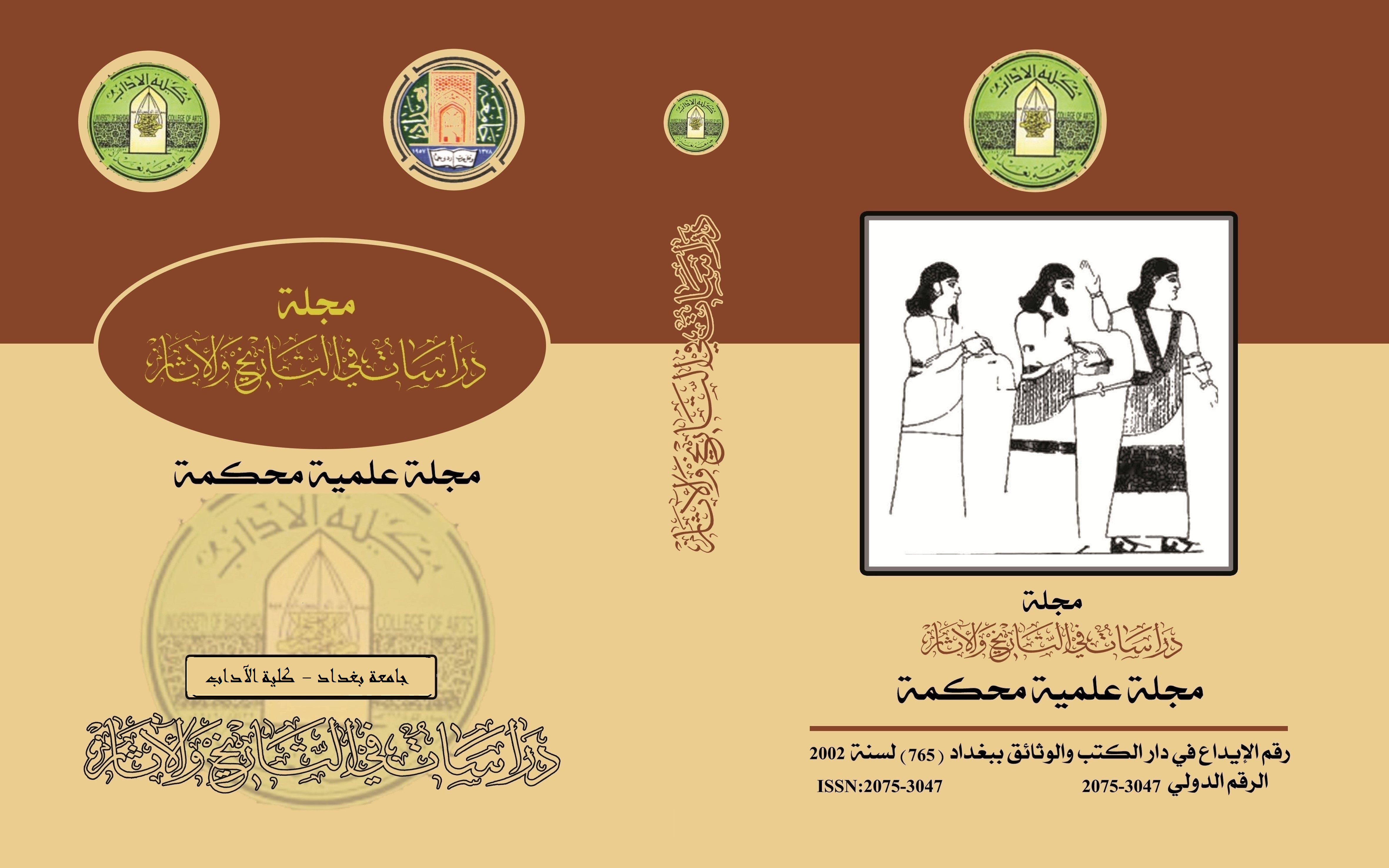تولي موواتالي الثاني العرش (1295-1272 ق.م)
الكلمات المفتاحية:
وراثة، عرش، تمردات، داخلية، خارجيةالملخص
استلم موواتالي الثاني الحكم بعد ابيه مورسيلي الثاني مباشرا كونه الوريث المناسب للحكم ولا يوجد مبدئيا من ينافسه على العرش ،لكن بعد ذلك واجه العديد من التحديات التي سيتم تناولها في هذا البحث المتمثلة اولا التمردات الداخلية المتمثلة بتامر زوجة ابية دانوخيبا ضده لأجل السيطرة على الحكم لصالح أبنائها الذين قتلوا فيما بعد في معركة قادش ولم يكن هذا السعي وراء العرش من جانب الاناث الاول من نوعه وانما ورد ذكره سابقا في المملكة القديمة بان ابنة حاتوسيلي تمردت أيضا ضد ابيها لأجل الحصول على العرش بتحريض ودعم من النبلاء الذين أغروها لدرجة أنها شهرت السلاح في وجه أبيها، وقضى حاتوسيلي على هذا التمرد.ثانيا تمرد داخلي من قبل تراهواندا ثالثا عدم انجابه ابنا له من الزوجة الرئيسية رابعا تمردات خارجية من قبل الكاسكا ومصر خامسا الطاعون وما خلفه سادسا خلافه مع ملك بابل.
المراجع
ا. ر. جرني (1997)، الحيثيون، تر: محمد عبد القادر محمد، مر: فيصل الوائلي، الهيئة المصرية العامة للكتاب.
ابو سعود صلاح (2017)، معالم تاريخ وحضارة الحيثيون ، ط1،مكتبة النافذة العالمية للكتب والنشر ، القاهرة .
بورت، دولا (1971)، بلاد ما بين النهرين ، حضارة بابل واشور، ترجمة : مارون الخوري ، بيروت.
الصالحي، صلاح رشيد (2011)، المملكة الحثية، دراسة في التاريخ السياسي لبلاد الاناضول.
عاشور، عماد عبد العظيم (د.ت)، سياسة النفي والابعاد في المملكة الحثية ، دراسات في اثار الوطن العربي 19، مصر، كليه الآداب، جامعة الفيوم.
المصادر الأجنبية
Albect, Goetze (1955), "Hittite Rituals in Context and Description of Festivals.
Aylan, Zafar Nima (2021), The political influence of Egypt in the Levant during the period (1580-1187. BC), International Journal of Creativity and Innovation in Humanities and Education, Zagazig University, Faculty of Education and Early Childhood, Vol. 1, 2021.
B.R. Kabatiarova (2006), "Ugaritic Seal Metamorphoses as a Reflection of the Hittite Administration and the Egyptian Influence in the Late Bronze Age in Western Syria," Ankara, June.
Beckman Gary (1983), "Inheritance and Royal Succession Among the Hittites," The Oriental Institute of the University of Chicago.
Beckman, Gary (1995), "The Royal Ideology and State Administration in Hittite Anatolia," Vol. 1, New York.
Bilgin Remzi Tayfun (2015), "Bureaucracy and Bureaucratic Change in Hittite Administration.
Bryce Trevor (2019), "Warriors of Anatolia: A Concise History of the Hittites," London, New York.
Bryce, Trevor (2003), "Hitit Dünyasında Yaşam ve Toplum," Birinci Baskı, Ağustos, Ankara.
Bryce, Trevor (2005), "The Kingdom of the Hittites," Oxford University Press Inc., New York.
Collins, Billie Jean (2007), "The Hittites and Their World," America.
Elizabeth, Anna Francina (2016), Van der Ryst "An Investigation into the Extensive Religious and Political Elements that Impacted on the Reigns of Hattusili III, Puduhepa, and Their Son, Tudhaliya IV (ca. 1267-1228 BCE)," University of South Africa, November.
Güterbock, Hans Gustav (1997), "Perspectives on Hittite Civilization: Selected Writings," Chicago, No. 26.
Haas Volkert (1994), "Geschichte der Hethitischen Religion," New York.
Moore, Michael (2018), "Hittite Queenship: Women and Power in Late Bronze Age Anatolia," University of California.
Murnane, William J. (1985), "The Road to Kadesh: A Historical Interpretation of the Battle Reliefs of King Sety I at Karnak," University of Chicago.
Singer, Itamar (1996). "Muwatalli's Prayer to the Assembly of Gods Through the Storm-God of Lightning." American Schools of Oriental Research. California.
Singer, Itamar (2006), "The Failed Reforms of Akhenaten and Muwatalli.
Sulyok, Gábor (2017), "Breach of Treaties in the Ancient Near East," Journal of the History of International Law 19.
Yakubovich, Ilya (2006), "Were Hittite Kings Divinely Anointed? A Palaic Invocation to the Sun-God and Its Significance for Hittite Religion.
التنزيلات
منشور
إصدار
القسم
الرخصة

هذا العمل مرخص بموجب Creative Commons Attribution 4.0 International License.
:حقوق الطبع والنشر والترخيص
بالنسبة لجميع البحوث المنشورة في مجلة دراسات في التاريخ والآثار، يحتفظ الباحثون بحقوق النشر. يتم ترخيص البحوث بموجب ترخيص Creative Commons CC BY 4.0 المفتوح ، مما يعني أنه يجوز لأي شخص تنزيل البحث وقراءته مجانًا. بالإضافة إلى ذلك ، يجوز إعادة استخدام البحث واقتباسه شريطة أن يتم الاستشهاد المصدر المنشور الأصلي. تتيح هذه الشروط الاستخدام الأقصى لعمل الباحث وعرضه.
:إعادة إنتاج البحوث المنشورة من الناشرين الآخرين
من الضروري للغاية أن يحصل الباحثون على إذن لإعادة إنتاج أي بحث منشورة (أشكال أو مخططات أو جداول أو أي مقتطفات من نص) لا يدخل في نطاق الملكية العامة أو لا يملكون حقوق نشرها. يجب أن يطلب الباحثون إذنًا من مؤلف حقوق النشر (عادة ما يكون الناشر).
يطلب الإذن في الحالات التالية:
بحوثك الخاصة المنشورة من قِبل ناشرين آخرين ولم تحتفظ بحقوق النشر الخاصة بها.
مقتطفات كبيرة من بحوث أي شخص أو سلسلة من البحوث المنشورة.
استخدم الجداول والرسوم البيانية والمخططات والمخططات والأعمال الفنية إذا لم يتم التعديل عليها.
الصور الفوتوغرافية التي لا تملك حقوق لنشرها.
لا يطلب الإذن في الحالات التالية:
إعادة بناء الجدول الخاص بك مع البيانات المنشورة بالفعل في مكان آخر. يرجى ملاحظة أنه في هذه الحالة يجب عليك ذكر مصدر البيانات في شكل "بيانات من ..." أو "مقتبس من ...".
تعتبر عروض الأسعار القصيرة معقولة الاستخدام العادل ، وبالتالي لا تتطلب إذنًا.
الرسوم البيانية ، الرسوم البيانية ، المخططات ، الأعمال الفنية التي أعاد الباحث رسمها بالكامل والتي تم تغييرها بشكل ملحوظ إلى درجة لا تتطلب الاعتراف.
الحصول على إذن
لتجنب التأخير غير الضروري في عملية النشر ، يجب أن تبدأ في الحصول على أذونات في أقرب وقت ممكن. لا يمكن لمجلة الآداب نشر بحث مقتبس من منشورات أخرى دون إذن.
قد يمنحك مالك حقوق الطبع والنشر تعليمات بشأن شكل الإقرار الواجب اتباعه لتوثيق عمله ؛ بخلاف ذلك ، اتبع النمط: "مستنسخ بإذن من [المؤلف] ، [كتاب / المجلة] ؛ نشره [الناشر] ، [السنة]." في نهاية شرح الجدول ، الشكل أو المخطط.



















